 Margaret Robertson in her teens ... in her twenties
Margaret Robertson in her teens ... in her twenties 

The Folk from the Wind Wound Isle > Chapter 19 : The Children of William Adie Robertson and Jane Mathieson
page 121
Margaret Catherine ROBERTSON (1890-1949) - married name HORMAN
Eldest child of William Adie Robertson and Jane Mathieson, born at Port Campbell on 27 August 1890. Margaret was named after her two grandmothers.
 Margaret Robertson in her teens ... in her twenties
Margaret Robertson in her teens ... in her twenties 
The family moved to Beulah in 1892 and Margaret’s father died there when Margaret was eleven years old. Jane continued on the farm and Margaret and her sisters helped with the milking and other chores.
After leaving school, Margaret worked for Cust and Sons Pty Ltd, General Merchants in Beulah. She commenced in the drapery department but later moved into the office where she did clerical work. “She studied and became an accountant, then reached the position of Secretary to the company and was in charge of the office from 1918 to 1926.
She was most efficient and had exceptional ability, as stated by J W Cust Managing Director in his reference.” 1 When the family farm was sold in 1926, Margaret and her mother moved to Melbourne.
On 5 May 1927 Margaret married William Joseph HORMAN (1894-1963) at the Armadale Baptist Church. The Rev Dr Boreham conducted the service. Margaret’s sister Adie was married in the same church the following year. William Horman was the eldest son of William Ellis Horman and Mary Cobbe. He served in the AIF at Gallipoli and in France during World War I, rising to the rank of Sergeant. He was wounded in action and received a Military Medal for ‘bravery in the field’. 2 After their marriage Margaret and Bill lived at Dimboola, where William was the manager of Williams the Shoemen’s store. The couple had two children, Beryl (1928), and William (1932).
Margaret’s mother, Jane, lived with the family at Dimboola. “Grandma would take Beryl with her to the morning service at the Presbyterian Church; and in the evening Grandma would mind the children while Margaret and William attended the Methodist Church service”. In 1936 the family moved to Hartwell in Melbourne, then to Canterbury. They attended the East Camberwell Baptist Church.
page 122
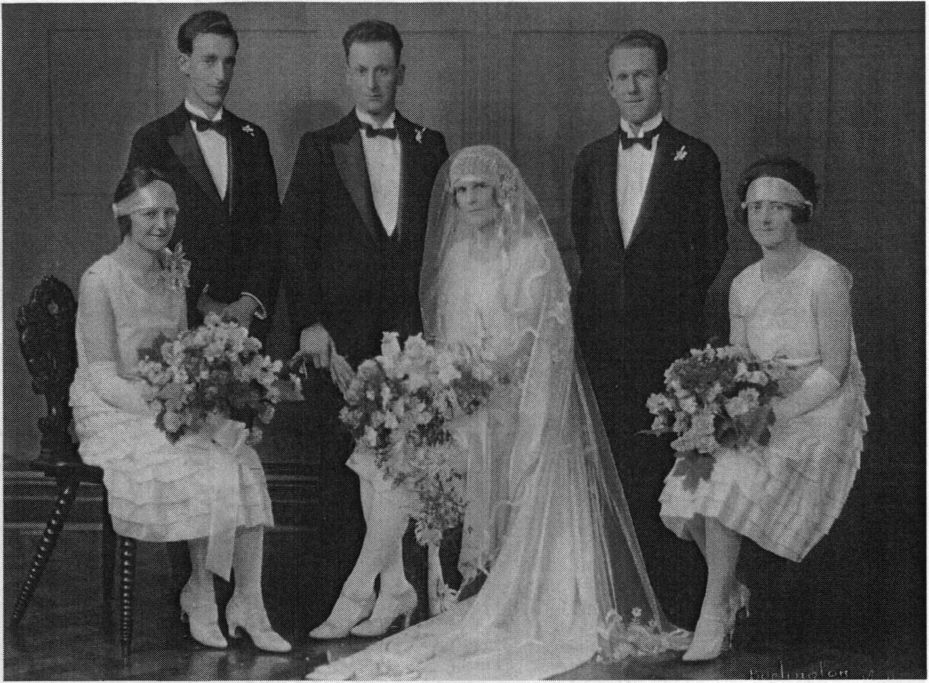
Margaret Robertson and William Horman
On their Wedding Day in 1927. The bridesmaid on the left is Margaret's sister Adie.
Margaret was very involved in church activities. She was President of the Ladies Guild and later President of the Eastern Suburbs Fellowship. She was a good public speaker and the author has been given a copy of an address written by Margaret Horman entitled ‘Shall We Worry’, based on texts from the Bible. Margaret belonged to the Country Women’s Association and during the Second World War she was a member of the Comforts Fund. She played the piano and sang with a lovely contralto voice. One of Beryl’s earliest memories is of her mother sitting at the piano, playing and singing to her.
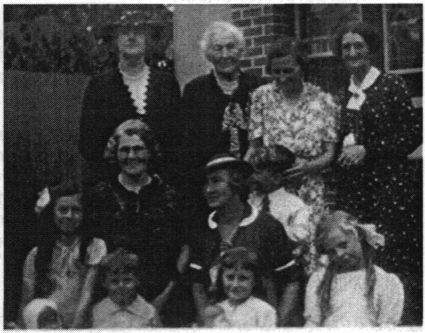
Horman family gathering
Margaret wearing glasses is in the centre. Her mother Jane is the white haired women at the back and daughter Beryl is at the right of the front row.
Later Margaret and Beryl played and sang duets together. Margaret wrote poetry and was a fine needlewoman. She was also a gifted artist, working in oils and charcoal and Beryl has some of her paintings.
When the family moved to Melbourne, William took up a position as executive inspector with Williams the Shoemen, going to the firm’s fifty-two stores checking shops, stock and books. William worked for Williams the Shoemen for fifty-five years and was still in their employ when he died after a heart attack in 1963. 4 His father had also worked for Williams the Shoemen for fifty years, “a unique family record in any firm.” Beryl describes her father as a strong man in both physique and character, with high moral values - things were black or white, good or bad. “He had a great sense of humour just like our mother.” 5
page 123
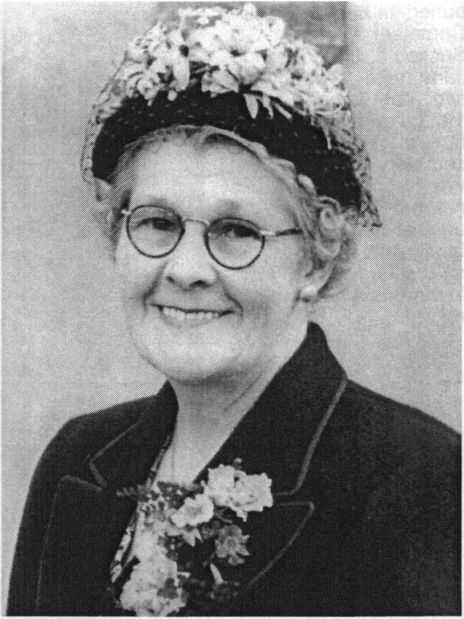 Margaret predeceased her husband, dying suddenly from a cerebral haemorrhage at the age of fifty-nine. She had outlived her mother by only ten months. The family were devastated by her unexpected death. Like her mother Margaret was cremated and her ashes placed in the family grave at Beulah.
Margaret predeceased her husband, dying suddenly from a cerebral haemorrhage at the age of fifty-nine. She had outlived her mother by only ten months. The family were devastated by her unexpected death. Like her mother Margaret was cremated and her ashes placed in the family grave at Beulah.
Margaret Robertson Horman, August 1949 >
Flora Jane ROBERTSON (1892-1922) and Ruby Barbara ROBERTSON (1894-1920)
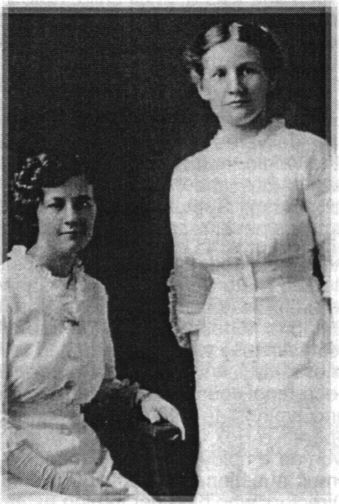
Flora and Ruby Robertson
I have put these sisters together as there seems to be some confusion about their lives and deaths and I have had contradictory accounts. They were the second and third children of William Adie Robertson and Jane Mathieson. Flora Jane was born either at Port Campbell or Beulah in 1892. Ruby Barbara was born at Beulah in 1894. The name Flora came from Jane’s sister, and Barbara from William’s sister.
Flora had typhoid fever when she was in her teens and all her hair fell out. When it grew back, her hair was a mass of tight curls.
Ruby was engaged to an Alan Whitney. Alan suffered from tuberculosis and because of his illness, he lived in a tent in the Robertson’s back yard at Beulah (fresh air and sunshine were part of the treatment for TB at the time).
“Ruby was very caring in nature and as she did the cooking for the household [she] would have tended Alan in his illness”. 5 Alan died before the couple could marry but he had passed his illness on to Ruby. In the process of nursing Ruby, Flora also contracted TB.
page 124
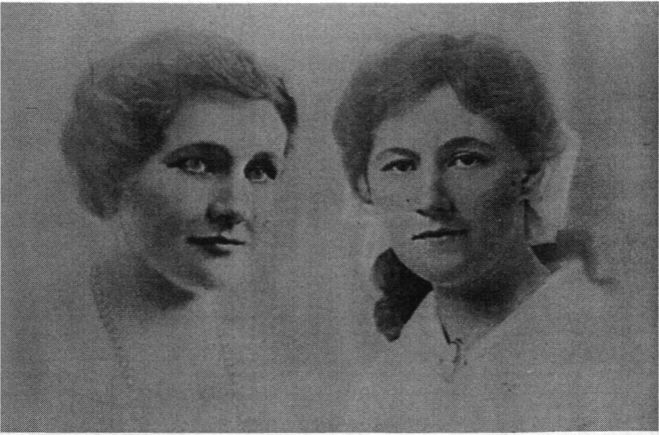 Flora and Ruby Robertson >
Flora and Ruby Robertson >
In an effort to combat the illness, Jane took the two girls to Queensland. Ruby died on 27 October 1920 and is buried in the Bald Hills Cemetery - Portion GD, Section 5, Lot 85. 6 Flora Jane died at Sandgate two years later, 2 August 1922, and is probably buried in the same cemetery as her sister. What appears to be a lot number - 265 - recorded against her name in the family bible, does not correspond with anything in the Brisbane Cemetery records.
Adie Agnes ROBERTSON (1899-1984) - married name TUNKS
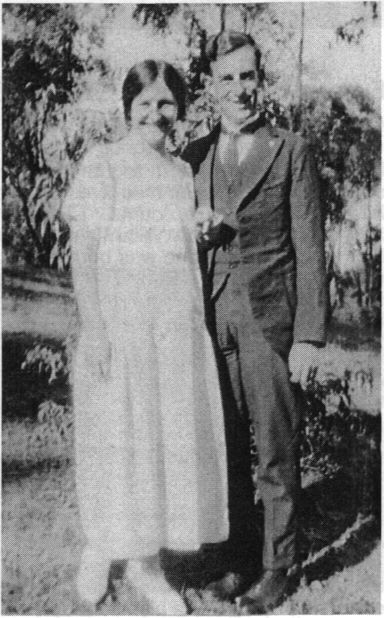
Adie Robertson and Roy Tunks on the occasion of their engagement
The youngest of William Adie Robertson and Jane Mathieson’s four daughters, born at Beulah on 8 December 1899. Adie’s names came from her father and his sister Agnes. Adie had no memory of her father as he died when she was twenty-one months old.
When she was a small child, Adie’s nightdress caught fire as she was standing in front of the wood fire after her Saturday night bath. Jack McCue, who was staying with the family at the time, grabbed her and rolled her in the floor rug, saving her life.
Like her sisters Adie helped on the farm. Before school she delivered milk around the town on horseback.
She would then take the cows to the paddock for the day. After school, the cows had to be brought home for milking. Sometimes Adie would fall asleep in class but was never reprimanded by the teacher.
Adie obtained her Merit Certificate in 1914 at the Beulah State School. In 1919 she went to Melbourne where she boarded with a Mrs Whitney in North Carlton. Whether this is the same Whitney family as Alan Whitney who was engaged to Adie’s sister is not known, but it does seem probable. Undertaking a secretarial course Adie became proficient in shorthand and typing. In 1920 she began working for the Cooperative Box Company at Yarraville. “Being the first woman employee of the Company, her ability was at times questioned by outside clients, but never by the Directors who held her in high esteem as evidenced by
page 125
their appreciation of her services and testimonial when retiring prior to her marriage.” 7
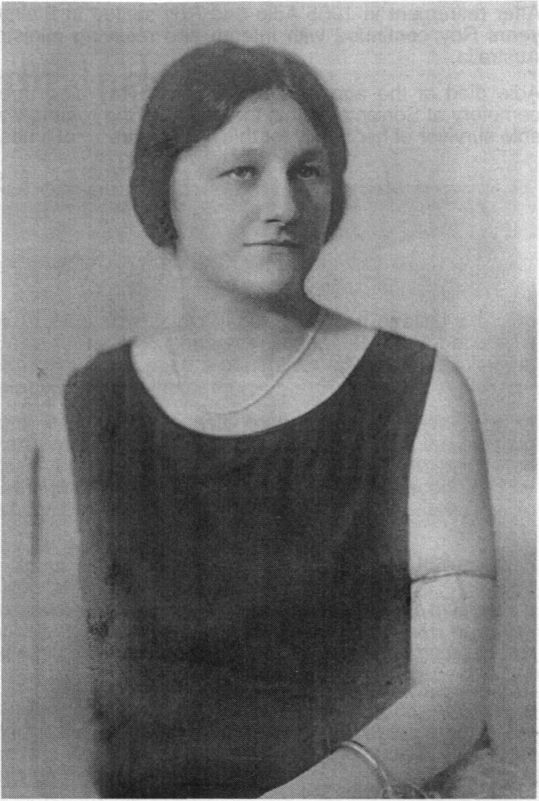 Adie spent some time in Brisbane when her mother took Ruby and Flora north for their health and Adie was at Sandgate when Flora Jane died there in 1922.
Adie spent some time in Brisbane when her mother took Ruby and Flora north for their health and Adie was at Sandgate when Flora Jane died there in 1922.
Adie Tunks >
Adie married Henry Roy TUNKS (1899-1987) at the Armadale Baptist Church on 12 January 1928. Adie remembered it as a very hot day with a temperature of 110°F at nine o’clock in the evening (approximately 43.5°C).
The couple had four children, Maurine (1928), Cynthia (1930), Spenser (1933) and Jocelyn (1941).
Roy Tunks had completed his training as a Baptist minister in 1927. He served at the Baptist Church in Sydney Rd, Coburg for eight years and also conducted services at Merlynston. 8 In 1936 Roy represented the Victorian Baptist Union at a Toe H Conference in London and enjoyed the experience of preaching in well-known churches there. While he was away, Adie and the three older children, along with Roy’s mother, lived at Sassafras in the Dandenong Ranges. It was the middle of the Depression and times were hard. “Though it was a difficult time financially, we all enjoyed such happy times walking and exploring Sherbrooke Forest with its huge towering eucalypts and myriad birds and always searching for the lyrebirds.
We walked to school so often when the clouds were drifting with us - they were happy childhood days.” Beryl Horman remembers being sent on the train to visit her aunt and cousins in Sassafras with two cases, a small one containing her clothes and a large one packed with food. 9
Returning from England Roy resigned from the Baptist Church, joined the Anglican Church and became an Anglican minister after undertaking two years training. In 1939 the family moved to Moorabbin where Roy was given charge of St David’s Anglican Church. He ministered there for twenty-six years. After World War II the area developed rapidly and “was no longer a sleepy small suburb halfway to Frankston”. Roy oversaw the building of a new brick church and this was dedicated in 1956.
Maurine writes about her mother, “Mum cared for us all with patience and understanding and always support for Dad in the activities of the Parish. She was loved by all and is remembered kindly.” Adie loved Scottish songs and the skirl of the bagpipes. She sang with the Church choir and was a member of the Royal Melbourne Philharmonic Choir which performed the ‘Messiah’ in the Melbourne Town Hall each Christmas.
Adie “loved riding and outdoor life, and always felt at home with cows and calves. When she was eighty years old she was delighted to ride in a 4WD to see the Angus herd on a friend’s farm in Tasmania.”
page 126
After retirement in 1965 Adie and Roy settled in Blairgowrie near Sorrento. Over the next ten years Roy continued with interim and relieving ministries in Victoria, Tasmania and Western Australia.
Adie died at the age of eighty-five and Roy died three years later. They are buried in the cemetery at Sorrento “within the sound of the roaring waves of Bass Strait - Mum had been the sole survivor of her family for thirty-five years ... at times she felt its loneliness.”
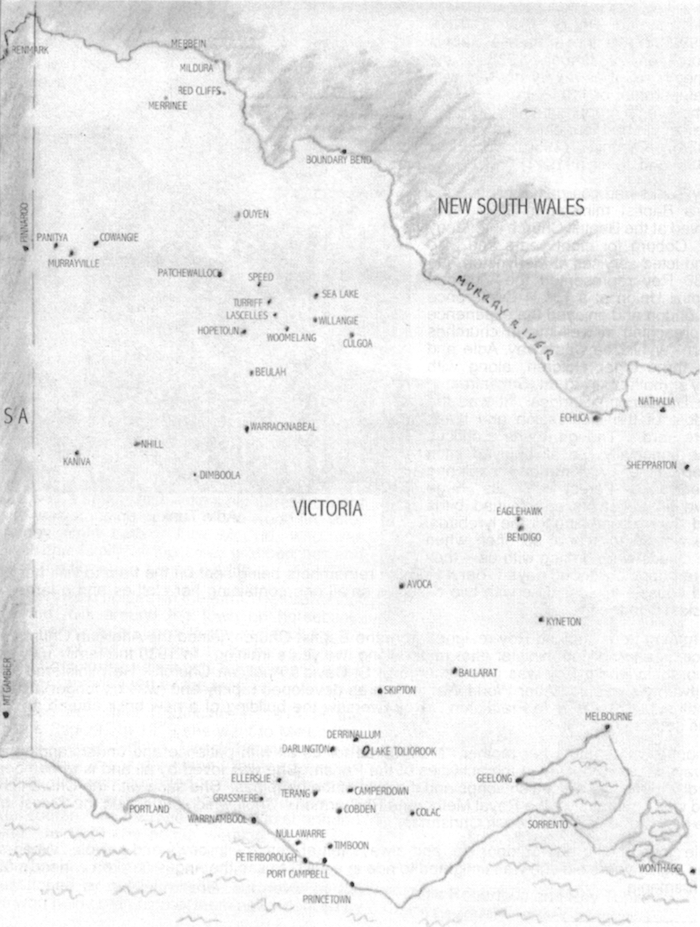
Map of relevant towns in Victoria, South Australia and New South Wales
1 Information about Margaret’s life was supplied by her daughter Beryl Oakes in letters and an interview, April 2000. This and other quotes are taken from letters.
2 William's Army record
3 This would include the period William spent in the AIF from 1915 to 1919.
4 Interview with B. Oakes, April, 2000
5 M Tunks, 17.9 2001
6 This information obtained from the Brisbane Cemetery Records in November 2000. They were unable to locate a record of Flora’s burial but this does not exclude her burial at Bald Hills or Redcliffe, which are the nearest cemeteries to Sandgate. There is no cemetery at Sandgate.
7 Most of the information about Adie comes from her daughter Maurine Port and this and other quotes are taken from her letter, 17.9.2001
8 F.J. Wilkin, ‘Baptists in Victoria’
9 Interview with B Horman, April 2000
Garry Gillard | New: 24 March, 2019 | Now: 5 September, 2022